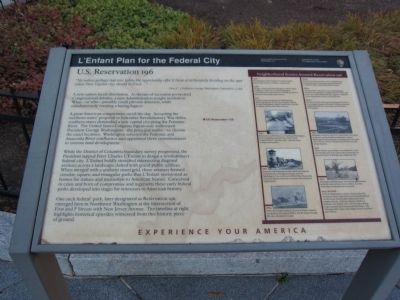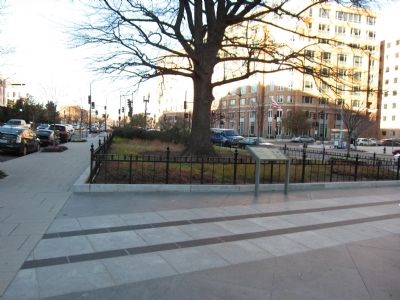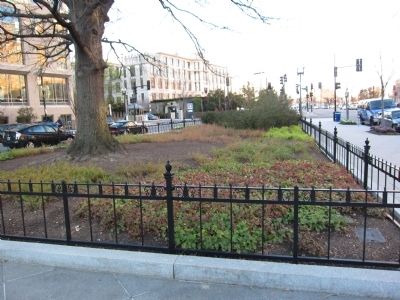Swampoodle in Northwest Washington in Washington, District of Columbia — The American Northeast (Mid-Atlantic)
U.S. Reservation 196
L'Enfant Plan for the Federal City
— National Mall & Memorial Parks, National Park Service, U.S. Department of the Interior —
"No nation perhaps had ever before the opportunity offer'd them of deliberately deciding on the spot where their Capital city should be fixed..."
- Peter C. L'Enfant to George Washington, September 11, 1789
A new nation faced dissolution. As threats of secession permeated Congressional debates, a new Administration sought resolution. What-or who-possibly could prevent disunion, while simultaneously creating a lasting legacy?
A great American compromise saved the day. Accepting the northern states' proposal to federalize Revolutionary War debts, southern states demanded a new capital city along the Potomac River. The United States Congress ingeniously authorized President George Washington-the principal unifer-to choose the exact location. Washington selected the Potomac and Anacostia River confluence and appointed three commissioners to oversee land development.
While the District of Columbia boundary survey progressed, the President tapped Peter Charles L'Enfant to design a revolutionary federal city. L'Enfant boldly stretched intersecting diagonal avenues across a landscape dotted with grand public edifices. When merged with a uniform street grid, these avenues formed circular, square, and triangular parks that L'Enfant envisioned as homes for statues and memorials to American heroes. Conceived in crisis and born of compromise and ingenuity, these early federal parks developed into stages for witnesses to American history.
One such federal park, later designated as Reservation 196, emerged here in Northwest Washington, at the intersection of First and F Streets with New Jersey Avenue. The timeline at right highlights historical episodes witnessed from this historic piece of ground.
Neighborhood Scenes Around Reservation 196
1792 - Development of the Federal City, following the master plan of Peter L'Enfant, commenced.
1799 - To spur commercial development as well as signal confidence in the city, George Washington commissioned construction of a double townhouse that stood on North Capitol Street.
1814 - British troops marching from Bladensburg, Maryland entered the city, burning the Capitol, George Washington's double townhouse, and the President's House (the White House).
1850 - Between G and H Streets in Northeast Washington, Irish immigrants named their Tiber Creek neighborhood, "Swampoodle," after its many swamps and puddles.
1861 - From the old Baltimore & Ohio Railroad Station, President-Elect Abraham Lincoln entered Washington City on the eve of Civil War; thousands of new residents followed in search of housing and employment.
1865 - After shooting President Lincoln at Ford's Theater on April 14, actor John Wilkes Booth raced through this area during his escape.
1870s - Natural gas and sewer lines, street regrading and paving, and park landscaping greatly improved conditions within adjoining neighborhoods.
1880s - "Swampoodle" emerged as one of Washington's notorious and dangerous neighborhoods, while, just to the west, fashionable Judiciary Square residences housed prominent citizens and politicians.
1890s - Electric streetcar rails appeared along First Street, encouraging expansion beyond L'Enfant's planned neighborhoods into other parts of the District of Columbia.
1892 - Benjamin Harrison, the first United States President to attend a professional baseball game, joined Washington Nationals fans at Swampoodle Grounds (now the sites of the National Postal Museum and Union Station).
1907 - Union Station successfully consolidated the city's several railroads, but required the destruction of several historic buildings and neighborhoods.
1927 - Throughout Washington, the Federal government initiated some urban renewal efforts, but this immediate residential area survived.
1945-present - Postwar Washington remains characterized by numerous large-scale urban renewal and highway construction projects that obliterated entire neighborhoods. Judiciary Square remains a shadow of its former self, now serving as home to government and commercial structures. The "Swampoodle" name and neighborhood vanished into history.
Erected by National Park Service, U.S. Department of the Interior.
Topics and series. This historical marker is listed in these topic lists: Government & Politics • Notable Buildings • Notable Places • Settlements & Settlers. In addition, it is included in the Former U.S. Presidents: #01 George Washington, the Former U.S. Presidents: #16 Abraham Lincoln, and the Former U.S. Presidents: #23 Benjamin Harrison series lists. A significant historical year for this entry is 1792.
Location. 38° 53.815′ N, 77° 0.719′ W. Marker is in Northwest Washington in Washington, District of Columbia. It is in Swampoodle. Marker is at the intersection of 1st Street Northwest and New Jersey Avenue Northwest, on the right when traveling north on 1st Street Northwest. Touch for map. Marker is at or near this postal address: 500 New Jersey Avenue Northwest, Washington DC 20001, United States of America. Touch for directions.
Other nearby markers. At least 8 other markers are within walking distance of this marker. Workers Memorial Day (within shouting distance of this marker); Victims of Communism Memorial (about 600 feet away, measured in a direct line); a different marker also named Victims of Communism Memorial (about 600 feet away); Cristoforo Colombo (approx. 0.2 miles away); Famine-Genocide in Ukraine (approx. 0.2 miles away); Japanese American Memorial to Patriotism During World War II (approx. 0.2 miles away); On This Corner … (approx. 0.2 miles away); Acacia Life Insurance Building – 1936 (approx. 0.2 miles away). Touch for a list and map of all markers in Northwest Washington.
Credits. This page was last revised on May 28, 2023. It was originally submitted on October 7, 2012, by Craig Swain of Leesburg, Virginia. This page has been viewed 752 times since then and 26 times this year. Photos: 1, 2, 3. submitted on October 7, 2012, by Craig Swain of Leesburg, Virginia.


